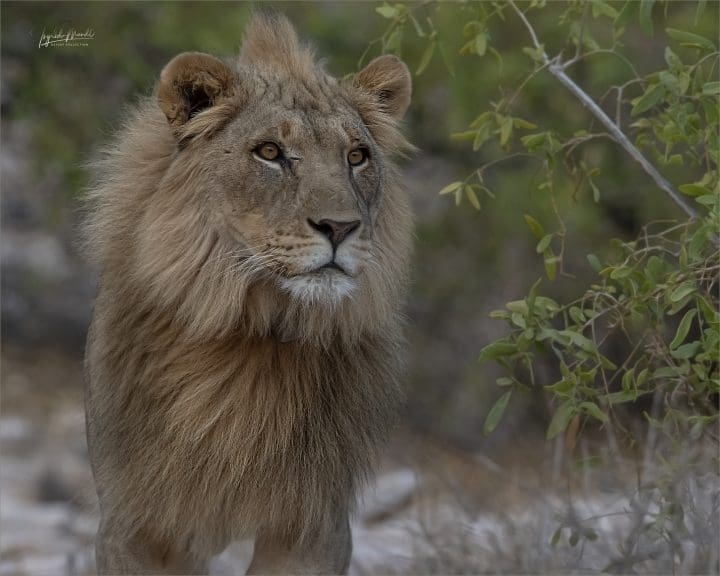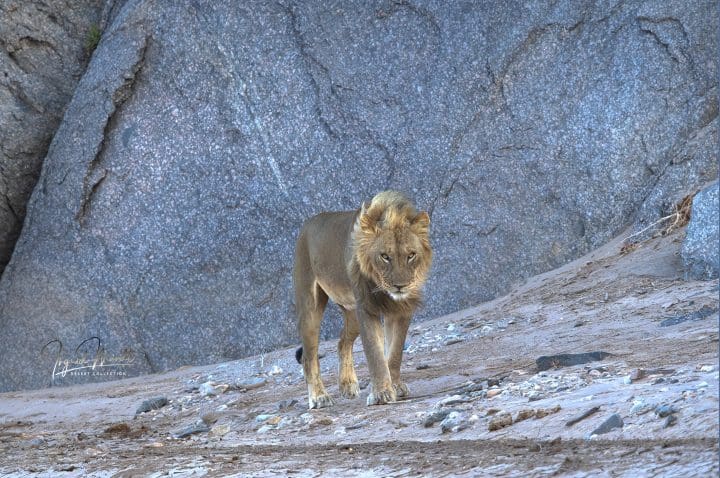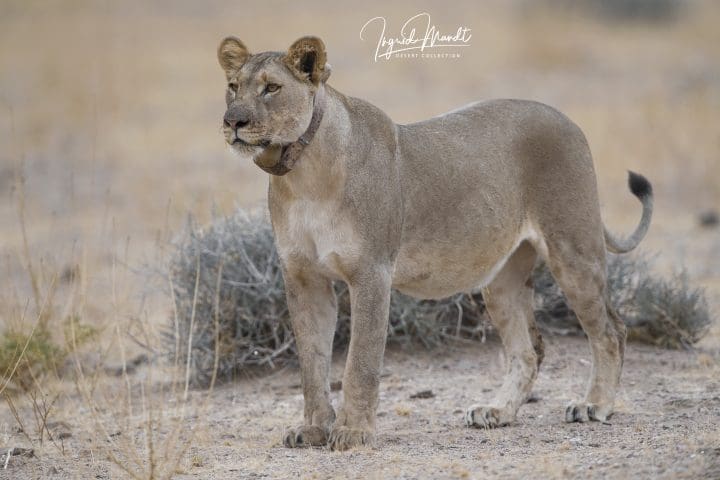The future for the desert lions living in northwest Namibia is “very, very bleak”, according to Izak Smit, chair of an organisation devoted to the lions’ survival.
Numbers alone tell their story. Between 2016 and 2022, the population has plummeted by around two-thirds. Smit says there are now only 35-45 lions left.
The Canary first reported on the lions’ plight in Spring 2021, when images of emaciated individuals in the region emerged. At the time, the government pledged to take action. Said action included the development of a long-term plan for their conservation.
But the chair of Desert Lions Human Relations Aid (DeLHRA) recently told The Canary that little has materially changed for the lions since then – certainly not enough to turn their fortunes around.
A perfect storm
As The Canary previously explained, multiple factors have contributed to the desert lions’ bleak situation. Namibia has experienced successive and prolonged droughts in recent years. This has been particularly punishing in the Kunene region where the lions are located. The droughts have led to the widespread loss of farm animals and crops on which people depend.
Moreover, the government sanctioned the excessive use of wildlife prior to, and partially during, the droughts. A core aspect of Namibia’s conservation model is the so-called sustainable use of wildlife. This can range from wildlife tourism to trophy hunting and trading in wildlife. In around 20% of the country, communities manage such use in designated areas called conservancies. This is known as Community-Based Natural Resource Management (CBNRM). Conservancies’ use of wildlife is guided by government directives and involves various organisations, such as trophy hunting operators and NGOs.
Sustainable use
Professor of environment and culture at Bath Spa University Sian Sullivan recently pointed out that the term ‘sustainable use’ is somewhat misleading. That’s because the ‘use’ of wildlife generally isn’t by communities themselves. Writing in the Land Magazine, Sullivan – who has decades of research experience in Namibia – said that in practice it means:
the extraction of wildlife and other ‘natural resources’ by commercial operators and consumers largely from outside these communities
Sullivan also asserted that some of the “rhetoric” from proponents of sustainable use “downplays” communities’ relations with wildlife. This rhetoric includes the idea that people would simply “despatch” species like lions and elephants if they weren’t getting income from their use. These species can be problematic to coexist with, but Sullivan said this perspective devalues:
long-established methods for living with indigenous fauna, as well as ways people care for and value wildlife which go beyond the minimal incomes received from hunters and tourists.
Plummeting populations
Christiaan Bakkes worked in Namibia on wildlife conservation for over 20 years. In 2019, he explained what impact the over-exploitation of wildlife during prolonged droughts could have on species’ populations in the arid northwest:
Over-utilisation of desert adapted wildlife puts added pressure on a population that will need the drought resistant strains to survive an extended dry period. This may cause the population to crash irretrievably.
Again, the numbers tell the story. According to sightings statistics compiled by the Namibian Association of CBNRM Support Organisations (NASCO), many wildlife populations in the northwest dramatically declined between in 2012 and 2019. 2012 was the year before the droughts set in. 2019 was the year after the government brought in a moratorium on its ‘shoot-and-sell’ policy. This was a sustainable use policy, whereby conservancies could contract hunters to kill wildlife to sell into the meat trade.
Bakkes highlighted that gemsbok, springbok, and zebra were key shoot-and-sell targets. Their numbers plummeted from 3,244 to 774, 11,711 to 4,384, and 2,583 to 830 respectively between 2012 and 2019. Gemsbok in particular have continued to decline since, with only 181 sightings in 2021.
Forced into conflict
Such declines are naturally bad news for predators like lions. The lack of prey species has seen some of them starve. Others, meanwhile, have tried to stay alive by preying on farmed animals. This brings them into conflict with farmers. According to Smit, the farmers themselves have also been pushing into areas reserved for wildlife in desperation during the drought, making human-wildlife conflict (HWC) more likely.
Other aspects of Namibia’s wildlife policy also interact with this volatile situation, with dire outcomes for some desert lions. The fate of Romeo, a male lion “in his prime” Smit says, is a case in point.

The Ministry of Environment and Tourism (MEFT) allowed a trophy hunter to pay for the thrill of killing Romeo in April. As a pride male, Romeo lived among a small group of lions and was fathering cubs. With males relatively few and far between in the population of desert lions, he was in essence key to their chances of survival, Smit suggests.
A problem desert lion?
In comments on the trophy killing, MEFT characterised Romeo as a “problem” lion. It said he was a threat to people and responsible for numerous farm animal deaths since 2019. This characterisation contradicts what the Lion Rangers had said about him. This is an NGO that monitors the lions and is supposed to intervene to limit HWC. Just weeks before his killing, the group explained in a blog that Romeo, who wore a collar for monitoring, had “gone on something of a walkabout”, risking conflict with farmers. They assured readers that they were “working tirelessly” to make sure he didn’t “develop any bad habits” because, critically, he was “not normally a conflict-causing lion”.
Smit also says that in November 2021, conservancy officials in the area called on MEFT to allow a trophy hunt of a lion. This wasn’t because any particular lion was causing problems, but because the hunt would provide some income to the conservancy.
In other words, a few things appeared to collide to seal Romeo’s fate. He was responsible for some farm animal predation, Smit says. But this wasn’t typical or consistent, according to those who monitored and knew him. Nonetheless, with community officials in need of funds, no shortage of hunters waiting in the wings, and a government devoted to the so-called sustainable use of wildlife, he became a target.

The Canary contacted MEFT for comment. It did not respond by the time of publication.
A failing policy
Smit says other lions – primarily younger males – have also died through deliberate, illegal poisoning as a result of HWC. At the start of the year, DeLHRA said their numbers were 45-55 individuals. Estimates stood at 85 a couple of years ago, and they were anywhere between 150 and 115 in 2016. Now Smit says there are only around 35-45 lions left. According to the Namibian, the country has seen almost 100 retaliatory lion killings since last year. Smit argues that:
This all just points to the fact that the human wildlife conflict policy of the ministry, as supposedly implemented by the NGOs they associate with, is a total failure. The result speaks for itself.
As The Canary has previously explained, DeLHRA has tried to convene a committee of conservancies in the region to discuss various changes. Smit believes these would limit HWC and benefit people as well as wildlife. The proposals include:
- Clearly delineating wildlife areas from farming areas and formally designating the former as protected areas.
- Rejuvenating those protected areas with, for example, the repopulation of prey species.
- Investing in turning protected areas into tourism destinations to provide income for communities.
- A review of the current memorandum of understandings (MOUs) between conservancies and NGOs. This process would ultimately lead to new MOUs with NGOs that can provide meaningful assistance to the communities in tackling HWC. The MOUs would be reviewed annually.
- The introduction of poverty-alleviating initiatives like hydroponic fodder and staple foods production. This is the quick production of foods in contained spaces. In terms of fodder, meaning farm animal feed, it can lower the risk of predation linked to grazing in open land.
Bandaids on bullet wounds
The DeLHRA chair says that efforts to find agreement on such changes have proved fruitless so far though, despite having grassroots support. He suspects this is due to the influence of NGOs on conservancy officials, saying the livelihoods of some of them “depend on the problem not going away”.
Smit explains that positive changes have happened in some areas. The opening up of a critical wildlife corridor between a national park called Etosha and the lions’ range continues to progress. The corridor will allow lions to travel in both directions and hopefully breed. But Smit says that this alone is not enough. Moreover, he argues that the HWC policy as its stands is largely reactive, not proactive, like “putting bandaids on bullet holes”.
MEFT’s statements give a different impression. Responding to recent concerns about malnourished lions in the area, its spokesperson Romeo Muyunda told the Namibian:
These lions have persisted throughout the recent drought and intermittent rains. Prey species have since slowly returned to their home ranges. As is to be expected, lion movements across the area have been incredibly dynamic as individuals and groups search for available, highly-mobile prey
“That’s it for them”
Smit provides a less rosy view, warning that their sparse remaining populations may be unviable. Genetic diversity is “severely limited” among the desert lions, he says. Moreover, their environment isn’t exactly conducive to recovery, thanks to over-utilisation of their prey, the drought, climate change, and human encroachment. He adds that the lions’ loss impacts all the other species dependent on the ecosystems in which the apex predators play a major role.
The DeLHRA chair offers an illustrative example on the lions’ plight. He talks about two female lions left in an area in the southern part of the Kunene region, sandwiched between two rivers.

He says that:
through inbreeding because of the males being shot, they are both sterile. So they’re in a dead end, they’re not going to propagate. That’s it for them.
Unfortunately for the females in question, Smit’s words turned out to be very prescient. On 12 September, the Desert Lion Conservation Trust revealed that one of them – Nala – had been found dead. The whereabouts of the other lioness are unknown.
The trust is trying to determine the cause of Nala’s death. But Smit believes it’s highly likely that the six-year-old female could have succumbed to starvation.
Featured and embedded images via DeLHRA
















